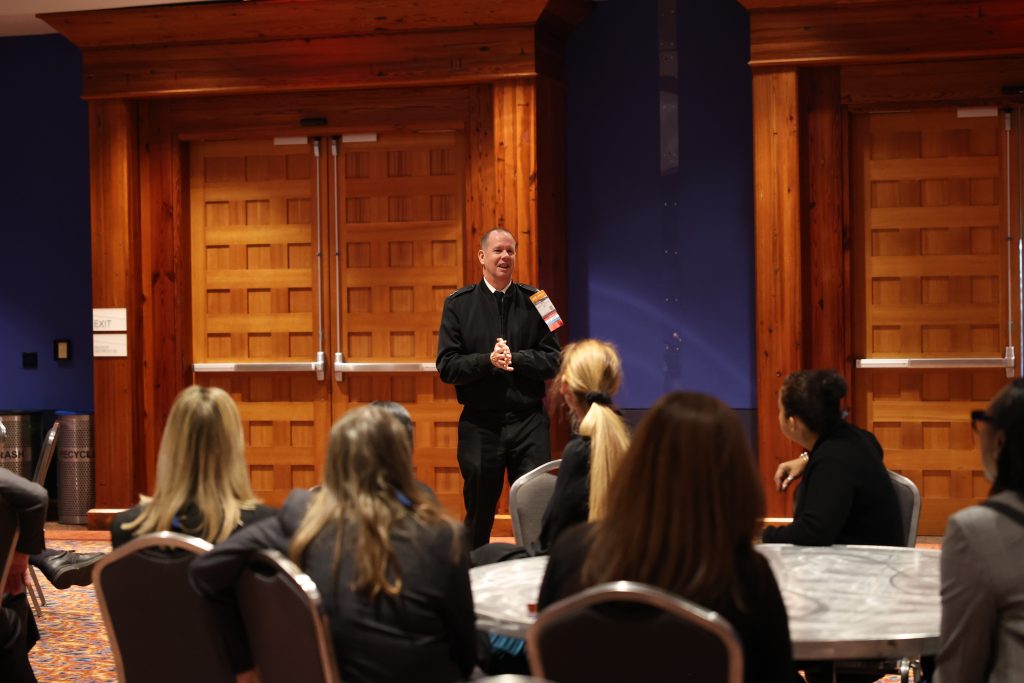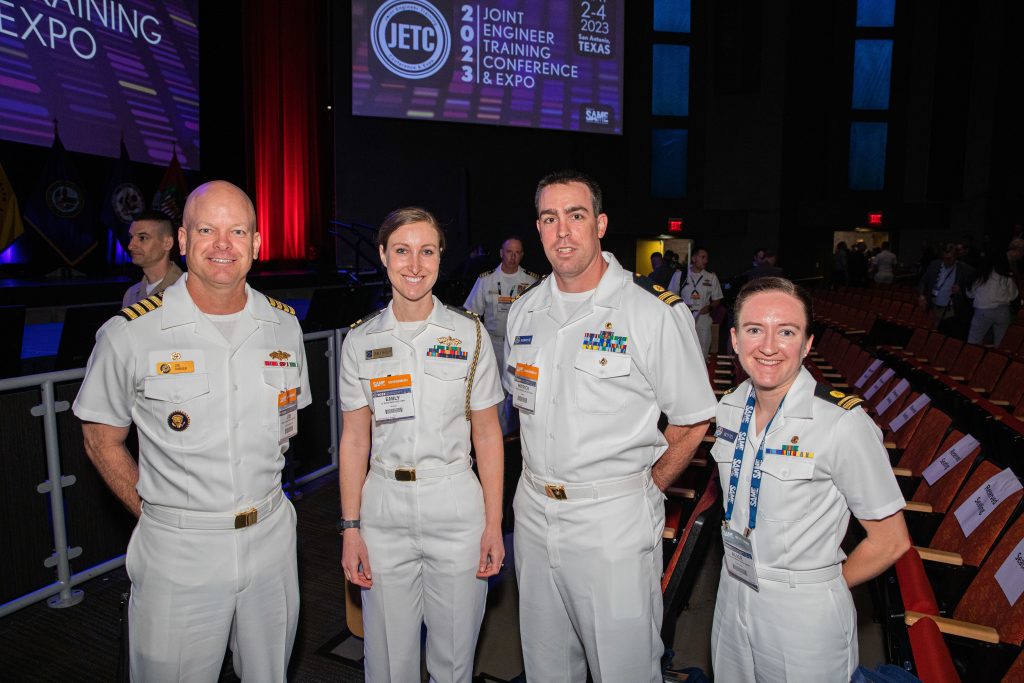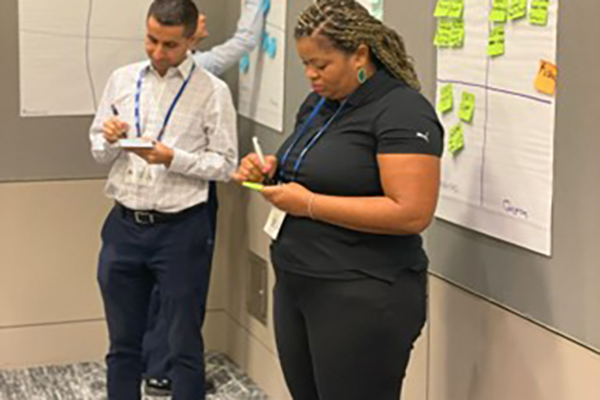Rear Adm. Dean VanderLey, P.E., CEC, USN
Commander, Naval Facilities Engineering Systems Command, and Chief of Civil Engineers

TME: Can you describe the mission, goals, and objects of NAVFAC and how they relate to the National Security Strategy?
VanderLey: As the Department of the Navy’s Systems Command for shore facilities and expeditionary equipment, Naval Facilities Engineering Systems Command (NAVFAC) has a varied responsibility that directly support warfighter lethality. We execute the planning, design, construction, and maintenance of shore infrastructure and facilities; cybersecurity of facility-related control systems; environmental compliance and remediation; real estate acquisitions and management; weight handling (crane) procurement and inspection; and expeditionary engineering and equipment procurement.
Driving continuously improving performance in these areas is our goal in order to effectively enable readiness and force generation for the U.S. Navy and U.S. Marine Corps.
America’s Navy is currently in a strategic power competition that requires staying ahead of its adversaries. NAVFAC enables that capability by delivering the systems and infrastructure to enable combat-ready forces vital to our nation’s security. The NAVFAC Strategic Plan is shaped by guidance set forth by the Secretary of Defense, Secretary of the Navy, the Chief of Naval Operations, and the Commandant of the Marine Corps. This plan accelerates our efforts to improve command-wide performance and develop a workforce for future challenges by driving outcomes to enable fleet readiness.
“A leading priority of mine has been to establish strong project team partnership and governance to engage the right stakeholders at the right level of leadership. This engagement serves to rapidly solve or elevate issues to maintain project flow and drive cost/schedule/quality performance based on clear key performance indicators.”
Our strategic priorities are aligned squarely with the Navy and Marine Corps:
- Accelerate Execution Performance with a focus on improving performance and accountability.
- Aggressively Exercise Systems Command Authorities to enable the fleet’s readiness and lethality through improved agility and leveraged expertise.
- Strengthen, Enhance, and Accelerate Workforce Learning and Performance by committing to technical excellence, measured outcomes, and increased workforce learning capacity.
TME: How have your previous leadership experiences influenced your approach to your position as NAVFAC Commander?
VanderLey: I’ve been blessed to have leadership opportunities at every level of our organization, from construction manager to public works officer to operations officer to commander. This diverse experience has given me a deep understanding of our business and the challenges and opportunities that our hard chargers face as they strive to succeed in their jobs. My goal is to leverage this experience and insight to institute initiatives that enable the success of our workforce and, ultimately, the success of NAVFAC and the entire Navy and Marine Corps team.
For example, delivering construction projects is a team effort requiring close collaboration with NAVFAC, stakeholders/customers, construction contractors, and A-E firms. How well these parties engage and work together is a primary enabler of success. A leading priority of mine has been to establish strong project team partnership and governance to engage the right stakeholders at the right level of leadership. This engagement serves to rapidly solve or elevate issues to maintain project flow and drive cost/schedule/quality performance based on clear key performance indicators.
As another example, much of the success or failure of any project depends on the effectiveness of the requirements determination, planning, and scope development. This is the foundation. To that end, I have worked to eliminate organizational stovepipes, engage our customers at the right leadership level, and ensure appropriate investment in the front-end planning. By getting this right from the beginning, we can minimize the later changes and re-work that drive cost and schedule growth, and meet our goal of delivering quality construction on time and within budget.
TME: How is NAVFAC leveraging technological innovations in modernizing its facilities and infrastructure?
VanderLey: To ensure the Navy remains ready and relevant in the defense of global U.S. interests, NAVFAC is leveraging technological innovations through a variety of approaches. We have established a command structure that seamlessly connects our research arm, the NAVFAC Expeditionary Warfare Center (EXWC), with leadership at NAVFAC Headquarters and our Criteria Office. As NAVFAC’s only warfare center, EXWC provides research, development, test and evaluation, and in-service engineering to deliver facility and expeditionary solutions to the warfighter. This structure serves as a catalyst for identifying emerging technologies that hold promise for enhancing our criteria documents for new projects.

NAVFAC prioritizes proactive engagement with supported commanders such as Marine Corps Installations Command and Commander, Navy Installations Command to ensure agility in our design and construction processes. Currently, there is an emphasis on modular and offsite construction methodologies, such as tension fabric structures, prefabricated systems, and 3D printing. These innovative approaches are considered as we initiate new projects, seeking efficient and cost-effective solutions to infrastructure challenges.
In our commitment to modernization, NAVFAC remains adaptable to evolving requirements—ensuring that our facilities meet current standards, including climate resilience, energy savings, and building electrification. We approach the evaluation of new systems with deliberate intent. While our sphere of influence is vast, we also must maintain a strategic focus on sustainment and operations, prioritizing the efficacy and long-term viability of any technology or system.
TME: How is NAVFAC building talent and developing its workforce to support the requirements of tomorrow?
VanderLey: NAVFAC’s third strategic priority is to strengthen, enhance, and accelerate workforce learning and performance. An ongoing investment in the development of our workforce is vital to success.
The first initiative within this strategic priority, to track the skills and certifications of our workforce, is to implement a robust Learning Management System (LMS). Last year, we began implementing “Waypoints,” a Navy-wide LMS that enables management and development of critical workforce competencies. Waypoints provides employees with access to manage their learning and career planning, as well as analytic tools for community managers to make data-driven decisions about the capability and capacity of our workforce to continuously and successfully meet the mission.
The second initiative, which was recently completed, was to re-engineer NAVFAC’s Knowledge Management System to allow employees to update processes quickly, capture lessons learned, and adapt to change, as well as collaborate on process improvement. As part of this effort, we developed a wiki-like tool within the Navy’s SharePoint environment that allows all levels of the organization and our workforce to propose process changes and collaborate in order to identify best practices and innovative ideas that inform standard processes. This collaborative virtual space for sharing ideas in a transparent manner has been a game changer, and it has already resulted in improved speed of process improvements and learning.
TME: What are some of the key challenges and opportunities ahead for NAVFAC?
VanderLey: Both the Navy and Marine Corps are making significant investments in shore infrastructure, which is leading to significant growth in military construction (MILCON). In FY2024, NAVFAC is expected to have the largest single-year MILCON workload ever at $8 billion. Much of this program is driven by investments in shipyard infrastructure, critical infrastructure and utilities, quality of life facilities, and support to the U.S. Indo-Pacific Command area of operations. Delivering projects on time and on budget in support to programs of this scale will be our greatest challenge over the next five years and our primary focus area.
In addition, we have made data-driven improvements to MILCON decision governance and criteria for elevating project issues. We also integrated NAVFAC’s planning and design organizations and processes to achieve more mature and budget-ready project scopes and cost estimates. These decisions were made possible by a commitment to performance transparency and fixing, or elevating, issues to keep construction efforts on track. Our FY2023 Performance Report provides data on our most consequential outcomes of MILCON delivery.
Another challenge we are deadline with is fully understanding and addressing the risk that we carry based on shore infrastructure condition. NAVFAC continually executes a robust infrastructure inspection and assessment program to develop required investments. My goal is to advance this analysis not just for investment, but to understand the potential risk to safety and operational readiness. Seizing this opportunity is critical to providing the fleets with increased leadership visibility on infrastructure condition and mission readiness. The responsibility also includes effectively communicating these risks and providing recommendations in order to manage and mitigate.
TME: How is NAVFAC deepening its collaboration and partnership with industry?
VanderLey: Deepening NAVFAC’s collaboration with industry is a top interest of mine, and we are taking deliberate steps to increase engagement through various avenues. We actively participate in opportunities through SAME such as the Joint Engineer Training Conference and Capital Week, and the Federal Contractors Conference hosted by AGC. These offer a great environment for engaging and informative exchanges with industry partners. We have improved our engagement on ad hoc issues by convening roundtable discussions to address specific challenges like supply chain, cost estimating, contracting strategies, and risk allocation. We are proactively seeking industry input more frequently to tackle complex problems sooner rather than solely relying on annual events.
Recognizing the magnitude of our program, NAVFAC acknowledges the necessity of partnering with industry. As our program expands to a record level, we understand that collaboration is essential for success. Consequently, we are expanding our project delivery methods, based on industry feedback, to broaden the use of other tools like integrated design and construction and early contractor involvement.
We are proactively collaborating across the Department of Defense to establish consistency in project delivery approaches, benefiting industry partners by reducing the need to adapt to varying procedures depending on the service they support. Ultimately, by strengthening our collaboration with industry, NAVFAC is better positioned to execute projects effectively and advance the mission objectives of the Navy and Marine Corps.
TME: How can organizations like SAME support NAVFAC’s needs?
VanderLey: Organizations like SAME play a pivotal role in enabling NAVFAC’s success. SAME facilitates collaboration, knowledge exchange, and networking opportunities by providing forums that allow for engagement between government and industry leaders. Through symposiums, conferences, and other collaborative venues, SAME creates a platform that facilitates opportunities for industry experts, engineers, and military professionals to converge and share insights and innovations. This collective knowledge pool enhances our capabilities, allowing for informed decision-making and the implementation of cutting-edge solutions.

SAME also contributes through professional development, offering relevant training sessions and workshops to keep NAVFAC personnel abreast of the latest technologies and industry trends. Additionally, in an era marked by rapid technological advancements, SAME’s commitment to education and professional development is indispensable. By investing in engineer, project manager, and leader training, SAME contributes to a talent pool that is equipped to meet NAVFAC’s present demands and prepared for the future challenges.
Through SAME initiatives such as the Communities of Interest, Pressing Issues for the SAME Executive Advisory Group, and listening sessions at national events, NAVFAC is able to connect with industry professionals to solve problems and gain an external perspective on our performance. By providing a bridge between military requirements and private-sector expertise, SAME enables NAVFAC to leverage the latest technologies and methodologies. Whether through mentorship programs, joint projects, or strategic alliances, SAME channels the ingenuity of its members to directly address our evolving needs. This contributes to NAVFAC remaining at the forefront of innovation and prepared to overcome the dynamic challenges that we face across the globe.
Rear Adm. Dean VanderLey, P.E., CEC, USN, assumed the duties of NAVFAC Commander and the 46th Chief of Civil Engineers in August 2022. He previously served as Commander, NAVFAC Pacific and held duties as Fleet Civil Engineer and N46, U.S. Pacific Fleet. Other command assignments include Commander, NAVFAC Atlantic; and before that, NAVFAC Mid-Atlantic; and Naval Mobile Construction Battalion 4. VanderLey is a graduate of Calvin College with a Bachelor of Science in Mechanical Engineering. He received his commission from the U.S. Navy’s Officer Candidate School in Newport, R.I., in 1991, then served in various positions aboard the USS Michigan (1993-1996). He holds a Master of Science in Civil & Environmental Engineering from Stanford University.
More News from TME
-

Strengthening Installation Energy Resilience Through a Community of Practice
The Military Energy Resilience Catalyst strengthens installation energy resilience by providing opportunities for energy practitioners to develop professionally and connect with experts, senior leaders, and colleagues. -

SAME DC & Baltimore – Sun. May 18 – Tour the N.S. Savannah (Free Event!)
Join the SAME DC & Baltimore Posts as we celebrate National Maritime Day 2025 with the N.S. Savannah Association for an open house tour of the N.S. Savannah on Sunday, May 18 from 10 am – 4 pm (Meet up at 1:30 pm). This event is free and open to the public. No RSVP is […] -

SAME DC – First Friday Webinar – May 2, 2025 – PFAS Compliance by 2029! Rapid Pathways to Success (1 PDH)
Join the SAME DC Post for this month’s virtual First Friday Webinar “PFAS Compliance by 2029! Rapid Pathways to Success” (1 PDH) featuring speaker Al LeBlanc, PE, CDM Smith. Free for SAME Members (any Post) and Students; $25 for non-members. Sponsorship for this event is available through annual or event sponsorship. Contact: Bree Beal, samedcprograms@gmail.com


